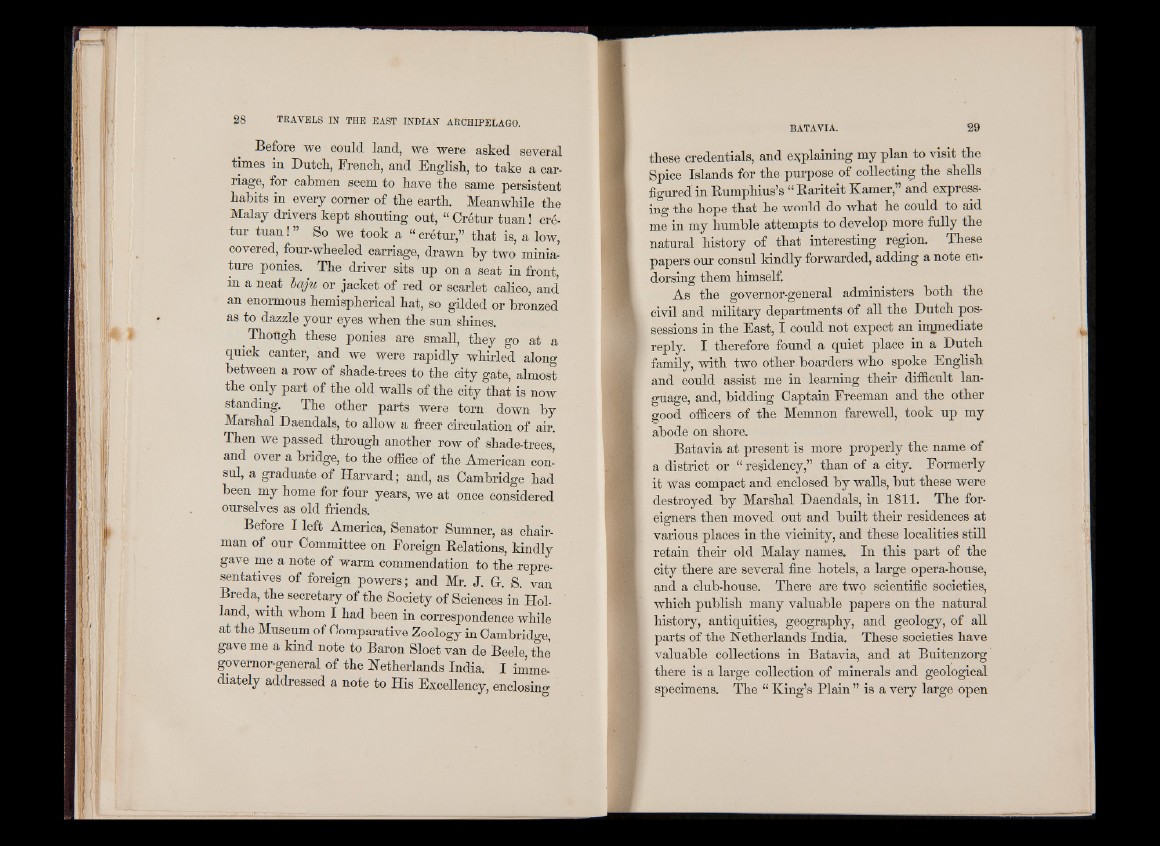
Before we could land, we were asked several
times in Dutch, French, and English, to take a car-
riage, for cahmen seem to have the same persistent
habits in every corner of the earth. Meanwhile the
Malay drivers kept shouting out, “ Crétur tu an ! eré-
tur tuan! ” So we took a “ cretur,” that is, a low,
covered, four-wheeled carriage, drawn by two miniature
ponies. ^ The driver sits up on a seat in front,
in a neat la ju or jacket of red or scarlet calico, and
an enormous hemispherical hat, so gilded or bronzed
as to dazzle your eyes when the sun shines.
Though these ponies are small, they go at a
quick canter, and we were rapidly whirled along
between a row of shade-trees to the city gate, almost
the only part of the old walls of the city that is now
standing. The other parts were torn down by
Marshal Daendals, to allow a freer circulation of air.
Then we passed through another row of shade-trees,
and over a bridge, to the office of the American consul,
a graduate of Harvard; and, as Cambridge had
been my home for four years, we at once considered
ourselves as old friends.
Before I left America, Senator Sumner, as chairman
of our Committee on Foreign Relations, kindly
gave me a note of warm commendation to the representatives
of foreign powers; and Mr. J. Gr. S. van
Breda, the secretary of the Society of Sciences in Holland,
with whom I had been in correspondence while
at the Museum of Comparative Zoology in Cambridge,
gave me a kind note to Baron Sloet van de Beele, the
governor-general of the Netherlands India. I immediately
addressed a note to His Excellency, enclosing
these credentials, and explaining my plan to visit the
Spice Islands for the purpose of collecting the shells
figured in Rumphius’s 11 Rariteit Kamer, and expressing
the hope that he would do what he could to aid
me in my humble attempts to develop more fully the
natural history of that interesting region. These
papers our consul kindly forwarded, adding a note endorsing
them himself.
As the governor-general administers both the
civil and military departments of all the Dutch possessions
in the East, I could not expect an immediate
reply. I therefore found a quiet place in a Dutch
family, with two other boarders who spoke English
and could assist me in learning their difficult language,
and, bidding Captain Freeman and the other
good officers of the Memnon farewell, took up my
abode on shore.
Batavia at present is more properly the name of
a district or “ residency,” than of a city. Formerly
it was compact and enclosed by walls, but these were
destroyed by Marshal Daendals, in 1811. The foreigners
then moved out and built their residences at o
various places in the vicinity, and these localities still
retain their old Malay names. In this part of the
city there are several fine hotels, a large opera-house,
and a club-house. There are two scientific societies,
which publish many valuable papers on the natural
history, antiquities, geography, and geology, of all
parts of the Netherlands India. These societies have
valuable collections in Batavia, and at Buitenzorg
there is a large collection of minerals and geological
specimens. The “ King’s Plain ” is a very large open